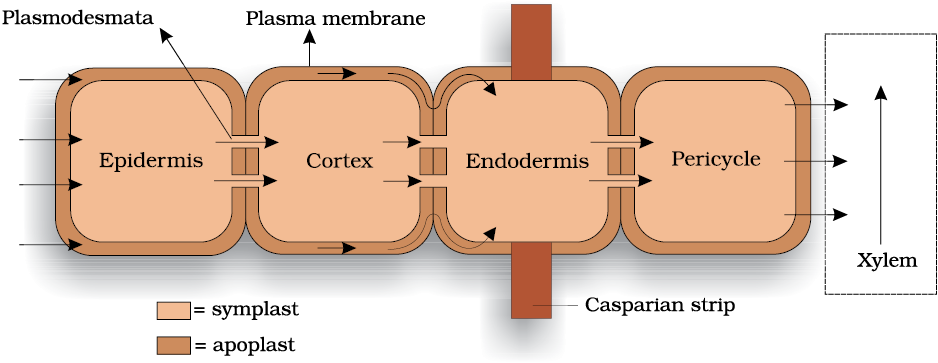We know that the roots absorb most of the water that goes into plants; obviously that is why we apply water to the soil and not on the leaves. The responsibility of absorption of water and minerals is more specifically the function of the root hairs that are present in millions at the tips of the roots. Root hairs are thin-walled slender extensions of root epidermal cells that greatly increase the surface area for absorption. Water is absorbed along with mineral solutes, by the root hairs, purely by diffusion. Once water is absorbed by the root hairs, it can move deeper into root layers by two distinct pathways:
• apoplast pathway
• symplast pathway

The apoplast is the system of adjacent cell walls that is continuous throughout the plant, except at the casparian strips of the endodermis in the roots (Figure 11.6). The apoplastic movement of water occurs exclusively through the intercellular spaces and the walls of the cells. Movement through the apoplast does not involve crossing the cell membrane. This movement is dependent on the gradient. The apoplast does not provide any barrier to water movement and water movement is through mass flow. As water evaporates into the intercellular spaces or the atmosphere, tension develop in the continuous stream of water in the apoplast, hence mass flow of water occurs due to the adhesive and cohesive properties of water.
The symplastic system is the system of interconnected protoplasts. Neighbouring cells are connected through cytoplasmic strands that extend through plasmodesmata. During symplastic movement, the water travels through the cells – their cytoplasm; intercellular movement is through the plasmodesmata. Water has to enter the cells through the cell membrane, hence the movement is relatively slower. Movement is again down a potential gradient. Symplastic movement may be aided by cytoplasmic streaming. You may have observed cytoplasmic streaming in cells of the Hydrilla leaf; the movement of chloroplast due to streaming is easily visible.
Figure 11.7 Symplastic and apoplastic pathways of water and ion absorption and movement in roots
Most of the water flow in the roots occurs via the apoplast since the cortical cells are loosely packed, and hence offer no resistance to water movement. However, the inner boundary of the cortex, the endodermis, is impervious to water because of a band of suberised matrix called the casparian strip. Water molecules are unable to penetrate the layer, so they are directed to wall regions that are not suberised, into the cells proper through the membranes. The water then moves through the symplast and again crosses a membrane to reach the cells of the xylem. The movement of water through the root layers is ultimately symplastic in the endodermis. This is the only way water and other solutes can enter the vascular cylinder.
Once inside the xylem, water is again free to move between cells as well as through them. In young roots, water enters directly into the xylem vessels and/or tracheids. These are non-living conduits and so are parts of the apoplast. The path of water and mineral ions into the root vascular system is summarised in Figure 11.7.
Some plants have additional structures associated with them that help in water (and mineral) absorption. A mycorrhiza is a symbiotic association of a fungus with a root system. The fungal filaments form a network around the young root or they penetrate the root cells. The hyphae have a very large surface area that absorb mineral ions and water from the soil from a much larger volume of soil that perhaps a root cannot do. The fungus provides minerals and water to the roots, in turn the roots provide sugars and N-containing compounds to the mycorrhizae. Some plants have an obligate association with the mycorrhizae. For example, Pinus seeds cannot germinate and establish without the presence of mycorrhizae.